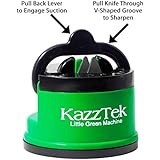Forget your fancy electric sharpeners and honing steels! For centuries, cultures across the globe have devised ingenious – and sometimes downright bizarre – methods for keeping their knives razor-sharp. These techniques, passed down through generations, reveal not only the resourcefulness of our ancestors but also the fascinating relationship between people and their tools. Let’s embark on a journey exploring some of the most unusual knife sharpening practices from around the world.
The Power of Stone: Ancient Methods and Modern Applications

The oldest and perhaps most ubiquitous method involved the use of stones. But “stone” is a broad term. Different cultures utilized various types of rock, each offering a unique sharpening profile. Indigenous populations in parts of North America, for example, employed fine-grained whetstones found along riverbeds, carefully selecting stones based on their texture and hardness. This meticulous selection process ensured the creation of a keen edge. The technique often involved a gentle rocking motion, maintaining consistent pressure to avoid damaging the blade. Similarly, in many parts of Asia, water stones – often composed of specific types of slate or sandstone – were (and still are) favored for their ability to produce incredibly fine edges, suitable for the intricate detail work involved in culinary traditions like sushi preparation. The use of water during the process helped to lubricate the stone, reduce friction, and wash away the metallic slurry created by the sharpening process.
Leather and Beyond: Unconventional Sharpening Surfaces

While stones remain the workhorse of traditional knife sharpening, some cultures have explored more unusual surfaces. In certain regions of Europe, particularly among shepherds and farmers, leather strops became a vital part of the knife maintenance ritual. After an initial sharpening on a coarser stone, the blade would be meticulously stropped on a piece of tanned leather, often treated with a sharpening compound like fine abrasive paste or even jeweler’s rouge. This refined the edge, resulting in an incredibly fine and sharp cutting surface. Similarly, certain indigenous communities in South America used hardened wood, polished to a mirror-like sheen, as a strop to hone their blades, demonstrating an exceptional understanding of the relationship between material hardness and sharpening effectiveness. The resulting edge would be remarkably smooth and fine.
Bone, Antlers, and Shells: Improvised Sharpening Solutions

Necessity, as they say, is the mother of invention. In environments where traditional sharpening stones were scarce, people displayed remarkable ingenuity. In several parts of the world, animal bones, particularly those with a dense, hard structure, were pressed into service. The ribs of large animals, for instance, provided a relatively coarse surface, ideal for initial sharpening or for heavily damaged blades. Antlers, with their layered structure, also offered a unique sharpening profile, often creating a serrated or slightly textured edge depending on the angle and pressure used. Similarly, the shells of certain large mollusks, such as clams or oysters, provided a surprisingly effective abrasive surface, particularly when used with a carefully applied slurry of water and grit.
The Importance of Torque (in the Context of Sharpening!)
While the concept of “torque” isn’t usually associated with hand-sharpening, it’s actually crucial. Torque, in this context, refers to the rotational force applied to the blade as it’s moved across the sharpening surface. A consistent, controlled torque prevents uneven sharpening and reduces the risk of chipping or damaging the blade. Think of it as applying a smooth, consistent pressure across the entire length of the blade. Improper torque can lead to uneven sharpening, with some parts of the blade sharper than others, making for a less effective and potentially dangerous tool. Mastering this subtle element is what separates a truly skilled sharpener from a novice.
Beyond the Basics: Modern Adaptations of Traditional Techniques
Many of these ancient techniques are still practiced today, often alongside modern methods. You’ll find artisans meticulously using water stones in high-end Japanese restaurants, or shepherds continuing their centuries-old traditions of leather stropping. The knowledge and skills passed down through generations are being revived and appreciated, highlighting the timeless value of these remarkable methods. Moreover, these traditional approaches offer valuable insights for modern knife sharpening enthusiasts, providing a deeper understanding of the principles of blade geometry and sharpening mechanics.
Conclusion: A Legacy of Sharpness

The diverse and ingenious methods of knife sharpening from across the globe showcase the enduring human connection with tools and our ability to adapt and innovate based on available resources. These seemingly simple acts of sharpening a blade are imbued with centuries of experience and demonstrate the ingenuity of people across diverse cultures. The next time you reach for your sharpener, remember the centuries of traditions and techniques that led to the perfectly honed edge of your knife.


